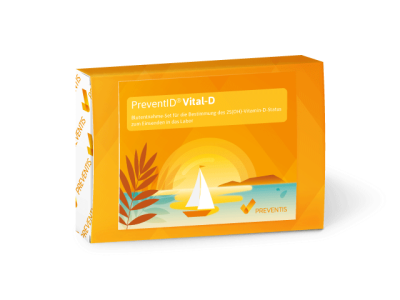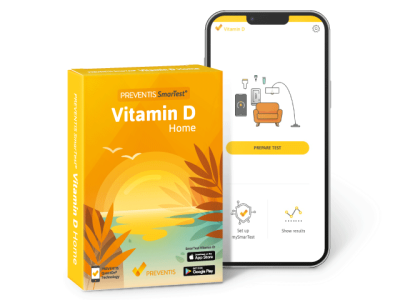Vitamin D is often called the “sunshine vitamin” – but is a summer full of sunshine really enough to maintain optimal levels? In this article, we explain how vitamin D is produced in the skin, why it matters, what role nutrition plays, and how you can easily measure your levels at home.
Vitamin D Production in the Skin: How Is It Made?
The human body has a fascinating ability: it can produce vitamin D on its own. A precursor, provitamin D3, is stored in the skin. When UVB rays from sunlight hit uncovered skin, this precursor is converted into previtamin D3. With warmth, it is transformed into vitamin D3, which is then activated in the liver and kidneys – only then can it take effect [1, 2].
The body’s own vitamin D synthesis is most efficient during midday. Studies show that UVB radiation is strongest between 10 a.m. and 3 p.m. Around noon (approx. 12–1 p.m.), just 10–15 minutes of sun exposure are often enough to trigger vitamin D production [4]. The amount of skin exposed also makes a difference: those who uncover arms, legs, or their back achieve optimal levels much faster than those exposing only face and hands [15].
Why Vitamin D Matters: Its Role in the Body
Vitamin D is involved in a wide range of bodily functions:
- Bones: Supports calcium absorption and strengthens bone structure [5].
- Muscles: Maintains muscle strength and coordination [6,14].
- Immune system: Regulates immune responses and has anti-inflammatory effects [7].
- Mental health: Can have a positive effect on depressive moods [8].
- Cardiovascular health: Plays a role in blood pressure and vascular regulation [9].
A long-term deficiency may lead to osteoporosis, muscle weakness, or an increased risk of infections [5, 7].
Vitamin D in Summer: Is Sunlight in Germany Enough?
Yes – summer months provide ideal conditions to replenish vitamin D stores. Short, regular periods of sun exposure around midday, with enough uncovered skin, are the most effective way to build vitamin D – without the need for long sunbathing sessions and without increasing the risk of skin damage [3, 4].
Finding the right balance is key: even short moments in the sun without protection are sufficient to produce vitamin D. Longer stays won’t raise levels further but will increase the risk of skin cancer [1]. Overproduction of vitamin D from sunlight is impossible – the body naturally stops production once a certain level is reached [11]. To safely improve vitamin D status, short periods without sunscreen can be considered in consultation with healthcare professionals.
Daily Vitamin D Needs: How Much Does the Body Require?
The German Nutrition Society (DGE) recommends a daily intake of 20 micrograms (800 IU) of vitamin D for adults if no vitamin D is produced via sun exposure [12]. This value is particularly relevant during the winter months in Germany when UVB radiation is insufficient.
However, targeted supplementation should only be considered after measuring individual vitamin D levels. A long-term overdose may pose health risks, including kidney problems or excessive calcium levels [13].
Vitamin D in Food: Which Foods Are “Vitamin D Bombs”?
Nutrition alone usually cannot cover the recommended daily dose of 20 µg (800 IU). Still, some foods are relatively rich in vitamin D and therefore considered “vitamin D bombs”:
To reach 800 IU through food alone, one would need unrealistic amounts – around 80 eggs or 2.4 kg of mushrooms per day [12, 13]. This is why sunlight remains the most important source.
Still, the only way to know if your body is truly well supplied is to measure your vitamin D levels.
Conclusion
Summer is the perfect time to boost vitamin D – short, regular moments in the sun without protection, paired with a balanced diet, are the most effective approach. During winter, however, sunlight in Germany is insufficient, making supplementation a reasonable option.
Regular testing also helps to detect deficiencies or excess early on and to keep your vitamin D status under control.
Your Easy Solution: SmarTest® Vitamin D and Preventis Vital D
With our tests, you can determine your vitamin D status conveniently at home – precise, fast, and without the need for a doctor’s appointment. Within minutes, you’ll know whether your levels are sufficient or if action is needed.


